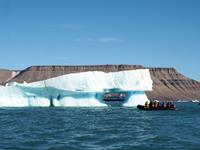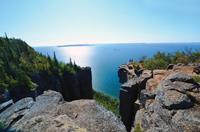There are plenty of reasons to celebrate Canada at the moment!
Lonely Planet has just named Canada their #1 destination for 2017 and the timing couldn't be better with the nation celebrating its 150th birthday next year. The final sections of the Trans Canada Trail, the world's longest network of recreational trails, are targeted to be completed in time for the celebration and the landmark anniversary will also see visitors enjoying free entry to National Parks across the country throughout the year.
A world first when it was established in 1911, Canada's National Park system today looks after more than 200 incredible National Parks, marine conservation areas and historic sites in every province and territory. With 47 National Parks and Reserves, dozens of UNESCO World Heritage Sites and Biosphere Reserves, hundreds of thousands of lakes, a handful of stunning mountain ranges, and the longest coastline in the world, it’s no easy task creating a ‘best of’ list of Canada's natural attractions. We’ve done our best and highlighted some personal favourites, but we invite and expect you to add your own! Feature Image: Ben Morin
-
NAHANNI NATIONAL PARK, Northwest Territories
 The Nahanni River. Photographer: Noel Hendrickson
The Nahanni River. Photographer: Noel Hendrickson
Amongst the World’s first ever UNESCO designated sites, this is a no-brainer for a top natural attraction. The iconic Nahanni River (the Naha Dehé in native Dene) runs 540km from the Mackenzie Mountains, with whitewater rushing through four of Canada’s deepest river canyons, past sulphur hot springs, granite peaks, alpine tundra, a unique limestone cave system, and enormous waterfalls including Virginia Falls which plunges into the river from a height nearly twice that of Niagara Falls. This is truly one of North America’s most spectacular, wild rivers.
See it for yourself: Nahanni River Adventure
-
COASTAL RAINFOREST, British Columbia
 Hiking the West Coast Trail. Photographer: Nicole Moreau
Hiking the West Coast Trail. Photographer: Nicole Moreau
The largest remaining intact temperate rainforest in the world, British Columbia's Coastal Rainforest is not only visually stunning, it also features the highest biomass by area of any ecosystem on earth. Amongst hundreds of species of plants and animals, fungi and lichens, the forest provides critical habitat for bald eagles, wild pacific salmon, grizzlies, black bears, and the rare Kermode (or ‘Spirit’) bear. More than half of the area is considered old-growth forest, with some trees as old as 1000 years! Of the most impressive are the gigantic Douglas Fir, Red Cedar, and Sitka Spruce trees which can be found scattered throughout Vancouver Island, the Great Bear Rainforest, and Gwaii Haanas National Park Reserve.
See it for yourself: West Coast Trail, Tofino Coastal Explorer, Haida Gwaii Adventure, Grizzly Bear Nature Adventure.
-
THE CANADIAN ARCTIC, Nunavut
 Croker Bay on Baffin Island
Croker Bay on Baffin Island
Though enormous in area, encompassing everything above the Arctic Circle, east of Alaska and west of Greenland, the far north of Canada represents less than 1% of the nation’s population. The result is vast, pristine wilderness and gigantic natural space with a landscape dominated by tundra, rock, snow and ice. During springtime in April and May, the floe edge (where the open sea meets the frozen sea) becomes one of the most dramatic and dynamic ecosystems on Earth, where arctic wildlife including walruses, seals, polar bears, narwhals, bowhead and beluga whales gather in abundance. At summer solstice, the ‘midnight sun’ shines for up to 24 hours; whereas during winter months, from October to March, one may experience only a few hours of sunshine per day, meaning plenty of deep dark skies and a front row seat for the magical Northern Lights.
See it for yourself: Northwest Passage East to West, Northwest Passage West to East, Arctic Safari
-
GROS MORNE NATIONAL PARK, Newfoundland & Labrador
 Atop the Tablelands in Gros Morne National Park
Atop the Tablelands in Gros Morne National Park
Most recognized for its dramatic fjords (a-la-Newfoundland & Labrador Tourism ads), Gros Morne National Park has also been recognized by UNESCO as a World Heritage site. The park is a geologist’s dream. Its Long Range Mountains represent one of the most northerly sections of the great Appalachian Mountain Range and, together with the fjords, provide an outstanding demonstration of glacier-scoured headlands in an ocean setting. This striking green landscape is set in strong contrast to the park’s copper-coloured Tablelands, a moon-like landscape where deep ocean crust and the rocks of the earth’s mantle lie exposed; one of the world’s best and most jaw-dropping illustrations of the process of plate tectonics.
See if for yourself: Gros Morne Traverse
-
THE BAY OF FUNDY, New Brunswick and Nova Scotia
 Hopewell Rocks, New Brunswick
Hopewell Rocks, New Brunswick
Twice each day, 160 billion tonnes of seawater flow in and out of the Bay of Fundy, resulting in the world’s highest recorded tides and one of the world’s greatest natural wonders. It is an incredibe experience to walk on the ocean’s floor at low tide, and then watch as water rises up to 50 feet above where you were just standing. Sea stacks and caves have been carved out of the landscape by the immense energy of the tides, and the huge intertidal zone is a highly productive, diverse natural ecosystem and part of a greater UNESCO-designated Biosphere Reserve. The mud flats are the perfect stop-over for millions of shorebirds migrating south each year, and the ‘neck’ of the bay is one of the best places for spotting humpback, finback, and right whales.
See if for yourself: Fundy Footpath Fall Colours
-
THE GREAT LAKES, Ontario
 View from the Top of The Giant, Ontario. Photo credit: OTMPC
View from the Top of The Giant, Ontario. Photo credit: OTMPC
Viewed from land or from air, the Great Lakes stretch far and wide giving an appearance more akin to a sea than to a freshwater lake. The series of five interconnected lakes from east to west are: Ontario, Erie, Huron, Michigan, and Superior. The only one outside of the province of Ontario (and Canada) is Lake Michigan, which is completely within the USA. Together, the lakes contain 21% of the world’s surface fresh water by volume, and Lake Superior alone is larger than many countries! The water’s surface level drops about 100m from Lake Superior to Lake Ontario, with the most dramatic drop occurring at a natural wonder on its own – Niagara Falls - on the river between Erie and Ontario.
See if for yourself: Superior Fall Adventure, Bruce Peninsula Traverse, Niagara Wines and Waterfront Trail by Bike
-
CANADIAN ROCKY MOUNTAINS, Alberta & British Columbia
 Parker Ridge Trail in Banff, Alberta. Photographer: Ben Morin
Parker Ridge Trail in Banff, Alberta. Photographer: Ben Morin
To just about everyone, apart from those who live in western Canada, the term “Rockies” represents just about all of the mountains from Alberta westward. This, of course, is not the case, as there are other mountain chains west of the Rockies, including the Coast and Columbia ranges and sub-ranges like the Purcells and Selkirks. The Rockies, specifically, are the rugged mountain peaks that form the spine of the Continental Divide and the border between the provinces of Alberta and British Columbia. Renowned for their scenic splendor (and earning yet another claim to UNESCO status), the Canadian Rocky Mountain Parks are comprised of Banff, Jasper, Kootenay, and Yoho National Parks and Mount Robson, Mount Assiniboine, and Hamber Provincial Parks. Together, they form a striking mountain landscape of icefields, canyons, glaciers, alpine meadows, turquoise lakes, waterfalls, and beautifully folded and uplifted sedimentary rocks. The perfect playground for adventure!
See it for yourself: Canadian Rockies Adventure, High Trails of the Canadian Rockies, Rocky Mountain Winter Adventure, Canadian Rockies Mountaineering Course, Yoho Peaks Expedition, Wapta Icefield Traverse